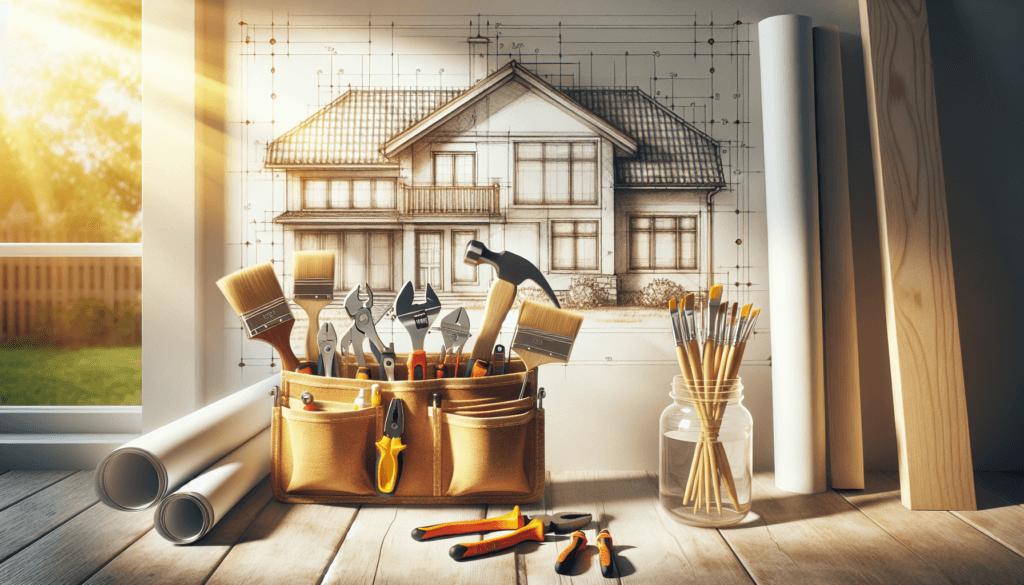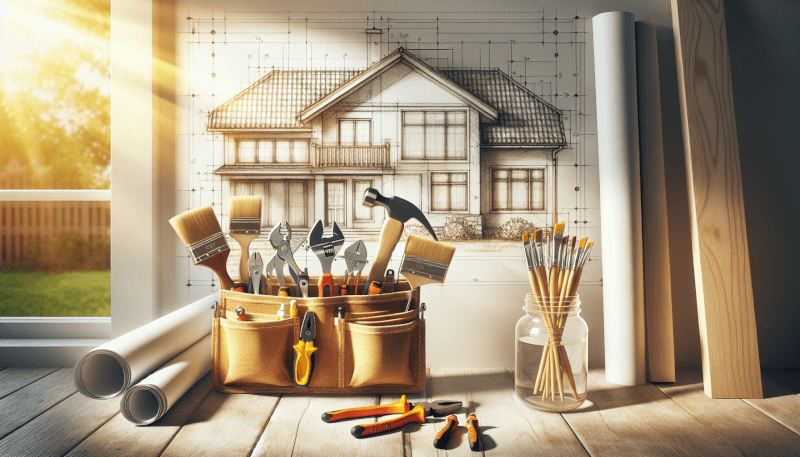So, you’ve been dreaming about bringing new life into your home, but you’re not sure where to begin. Well, fear not! In this article, we’ll guide you through the essential steps of starting your very own DIY home renovation project. Whether you’re a beginner or have some experience under your tool belt, we’ve got the tips and advice to help you embark on this exciting journey. From planning and budgeting to choosing the perfect projects, we’ll show you how to kickstart your transformation and turn your house into the home of your dreams. So, grab your hammer and let’s get started!

Planning and Initial Steps
Determine the Scope of the Project
Before undertaking a DIY home renovation project, the first step is to determine the scope of the project. Consider which areas of your home you want to renovate and whether you will be making any structural changes or focusing on smaller improvements. This will help you establish clear goals and prioritize your tasks as you move forward.
Set a Budget
Next, it’s essential to set a budget for your project. Determine how much you are willing to spend on materials, tools, and any professional help you may need. By establishing a budget early on, you can ensure that you stay within your means and avoid any financial strain throughout the renovation process.
Research Building Codes and Permits
Before starting any renovations, it’s important to research local building codes and permits. Depending on the nature of your project, you may need to obtain permits from your local government or adhere to specific regulations. Familiarize yourself with these requirements to ensure that you comply with all necessary regulations during the renovation.
Create a Timeline
Lastly, create a timeline for your renovation project. Estimate how long each task will take and establish a schedule for completing each stage of the renovation. Creating a timeline will help you stay organized and ensure that your project progresses smoothly. Be sure to account for any unexpected delays or setbacks that may arise during the renovation process.
Evaluating and Assessing
Inspect the Property
Once you have a clear plan and timeline, it’s time to inspect your property. Assess each area of the home that you plan to renovate, taking note of any existing issues or potential problem areas. This step will help you evaluate the condition of your home and determine the extent of the renovations needed.
Identify Problem Areas and Prioritize
After inspecting your property, identify the problem areas that require immediate attention. Whether it’s a leaky roof, a faulty electrical system, or water damage, prioritize these issues to ensure they are addressed before moving on to cosmetic improvements. By tackling essential repairs first, you can create a solid foundation for your renovation project.
Consider Hiring Professionals
While the appeal of a DIY renovation may be enticing, it’s important to recognize when it’s necessary to hire professionals. Complex structural changes, electrical or plumbing work, or tasks beyond your skill set should be left to experienced contractors. Consulting professionals will not only ensure the quality and safety of your renovations but can also save you time and prevent costly mistakes.
Designing and Selecting Materials
Gather Inspiration and Ideas
Take the time to gather inspiration and ideas for your home renovation project. Browse magazines, websites, and social media platforms for design inspiration. Create mood boards or Pinterest boards to help you visualize the look you want to achieve. By gathering inspiration, you can refine your vision and make informed decisions when selecting materials and finishes.
Create a Design Plan
Once you have gathered inspiration, it’s time to create a design plan for your renovation. Consider aspects such as layout, color schemes, and overall aesthetics. Develop a cohesive design concept that aligns with your personal style and complements the existing architecture of your home. Having a solid design plan will guide your decision-making process when selecting materials and ensure a cohesive end result.
Choose Materials and Finishes
With your design plan in hand, it’s time to choose the materials and finishes for your renovation. Consider factors such as durability, maintenance requirements, and budget when selecting materials for different areas of your home. Research various options and compare prices to find the best options that fit within your design vision and budget.
Obtaining Necessary Tools and Equipment
Make a List of Tools Needed
Before you can start your DIY renovation, make a comprehensive list of all the tools you will need. Assess the tasks you will be performing and determine which tools are essential for each step. From basic hand tools like hammers and screwdrivers to power tools like drills and saws, ensure that you have all the necessary tools on hand before you begin.
Rent or Purchase Tools
Once you have identified the tools you need, decide whether you will rent or purchase them. If you don’t already own certain tools or foresee limited future use, renting from a local tool rental service can be a cost-effective option. However, if you anticipate using the tools beyond this project, consider investing in quality tools that will last.
Ensure Safety Equipment is Available
Don’t forget about safety! As you gather your tools, be sure to also obtain the necessary safety equipment. Safety goggles, gloves, ear protection, and dust masks are just a few examples of essential safety gear. Prioritize your well-being by ensuring you have the appropriate safety equipment readily available throughout the renovation process.
Preparing the Work Area
Clear the Space
Before beginning any renovation work, clear the space of furniture, belongings, and any unnecessary items. This will allow for easy access to the areas you will be working on and minimize the risk of damage to your belongings. Store any furniture and belongings in a safe and secure location until the renovation is complete.
Protect Furniture and Belongings
For items that are too difficult or impractical to remove from the work area, take measures to protect them. Cover furniture and large fixtures with protective plastic or drop cloths to prevent damage from dust, paint, or debris. Take extra care when handling delicate or valuable items to ensure they remain unharmed throughout the renovation process.
Set up a Temporary Workspace
During a DIY renovation, it’s helpful to set up a temporary workspace. This area will serve as a hub for tools, materials, and any other items you regularly need. By creating a designated workspace, you can keep everything organized and easily accessible, saving time and reducing the risk of misplacing tools or materials.
Demo and Structural Work
Demolish Existing Structures
If your renovation requires demolishing existing structures, proceed with caution. Use appropriate safety equipment and follow proper demolition techniques to avoid injuring yourself or causing unnecessary damage. Start by removing fixtures, cabinets, or any other items that need to be replaced, then carefully demolish walls or other structures per your renovation plan.
Address Structural Repairs
Before proceeding with any other renovations, address any necessary structural repairs. This may involve reinforcing walls or floors, fixing foundation issues, or addressing any other structural problems identified during the evaluation phase. Hiring a professional for these tasks is highly recommended to ensure the integrity and safety of your home.
Install New Framework
Once any necessary structural repairs are complete, install new framework as needed. This might involve framing new walls, building additional support structures, or modifying existing layouts to accommodate your renovation plans. Take measurements accurately and follow building codes to ensure proper installation and safety.
Plumbing and Electrical
Evaluate Plumbing and Electrical Systems
During a home renovation, it’s crucial to evaluate the existing plumbing and electrical systems. Inspect pipes, drains, and electrical wiring for any signs of damage or wear. If you notice any issues, consult with a professional to determine the best course of action. Identifying potential problems early on will save you time and money in the long run.
Make Necessary Repairs or Replacements
If your evaluation reveals faulty plumbing or electrical systems, make the necessary repairs or replacements. This may involve fixing leaks, replacing outdated wiring, or upgrading fixtures to meet modern safety standards. While some repairs can be done by a competent DIYer, hiring a licensed professional is recommended for complex tasks to ensure compliance with building codes.
Install New Fixtures and Outlets
As part of your renovation, you may want to install new fixtures or outlets. Whether you’re updating your kitchen with a new sink, upgrading your bathroom with a stylish showerhead, or adding outlets to improve convenience, follow proper installation procedures and consult professionals if needed. Safety and compliance with electrical and plumbing codes should always be the top priority.
Installing Walls, Floors, and Ceilings
Frame and Install Walls
With any necessary structural repairs and framework taken care of, it’s time to frame and install walls. Follow building codes and your design plan to ensure accurate measurements and proper installation. Whether you are building new walls or repairing existing ones, take your time and double-check your work to create a sturdy and aesthetically pleasing end result.
Lay Flooring Materials
Installing new flooring can dramatically transform the look and feel of a space. Whether you choose hardwood, tile, laminate, or carpet, follow proper installation techniques and manufacturer guidelines. Properly prepare the subfloor, ensure evenness, and take care with cutting and fitting to achieve professional-looking results.
Install Ceiling Materials
If your renovation involves updating ceilings or installing new ones, carefully select and install the appropriate materials. This could include sheetrock, suspended ceiling tiles, or even decorative ceiling treatments. Be sure to follow installation instructions and take any necessary safety precautions when working at heights.
Painting, Wallpapering, and Finishing
Prepare Surfaces for Painting
Before painting or applying wallpaper, it’s crucial to properly prepare the surfaces. This involves cleaning, sanding, and priming walls and ceilings to ensure proper adhesion and a smooth finish. Repair any imperfections, such as cracks or holes, to create a clean canvas for your chosen finish.
Apply Paint or Wallpaper
Once the surfaces are prepped, it’s time to apply your chosen paint or wallpaper. Follow proper techniques and be mindful of drying times and ventilation. Paint or wallpaper one section at a time, ensuring even coverage and a seamless finish. Take your time and pay attention to detail to achieve the desired result.
Finish with Trim and Molding
To complete the look of your newly renovated space, add finishing touches such as trim and molding. Choose materials that complement your overall design plan and install them carefully and precisely. Properly measure, cut, and align each piece to create a polished and refined appearance.
Installing Fixtures and Appliances
Install Kitchen and Bathroom Fixtures
If your renovation involves updating the kitchen or bathroom, it’s time to install new fixtures. This may include sinks, faucets, toilets, showers, or bathtubs. Follow manufacturer instructions carefully and ensure proper plumbing connections to avoid leaks or other plumbing issues.
Mount Cabinets and Shelving Units
Installing new cabinets and shelving units can greatly enhance the functionality and aesthetics of your space. Measure accurately, use appropriate fasteners, and ensure level installation for the best results. If you are unsure about mounting heavy items, consider seeking professional assistance to ensure stability and safety.
Connect Appliances
If your renovation involves updating or adding new appliances, properly connect them to the plumbing, electrical, or gas systems. Follow manufacturer instructions and consult professionals if needed to ensure proper installation. Safety and compliance with codes should be the top priority when working with appliances.
By following these comprehensive steps, you can confidently embark on your DIY home renovation project. Remember to plan carefully, prioritize tasks, gather ideas, and consult professionals when necessary. With patience, dedication, and a friendly tone, your home renovation project will be a rewarding endeavor that results in a beautiful and personalized space. Happy renovating!


